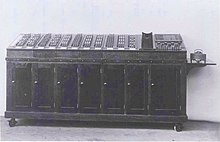| This article needs additional citations for verification. Please help improve this article by adding citations to reliable sources. Unsourced material may be challenged and removed. Find sources: "Mallock machine" – news · newspapers · books · scholar · JSTOR (December 2022) (Learn how and when to remove this message) |

The Mallock machine is an electrical analog computer built in 1933 to solve simultaneous linear differential equations. It uses coupled transformers, with numbers of turns digitally set up to +/-1000 and solved sets of up to 10 linear differential equations. It was built by Rawlyn Richard Manconchy Mallock of Cambridge University. The Mallock machine was contemporary with the mechanical differential analyser, which was also used at Cambridge during the late 1930s and 1940s.
References
- Mallock, R. R. M. (1933). "An electrical calculating machine". Proc. R. Soc. Lond. A. 140 (841): 457–483. Bibcode:1933RSPSA.140..457M. doi:10.1098/rspa.1933.0081.
- Finn, Bernard S. (2002). Exposing Electronics. NMSI Trading. pp. 64–73. ISBN 1-900747-48-0.
- Wilkes, M. V. (1940). "A Method of Solving Second Order Simultaneous Linear Differential Equations using the Mallock Machine". Mathematical Proceedings of the Cambridge Philosophical Society. 36 (2): 204–8. Bibcode:1940PCPS...36..204W. doi:10.1017/S0305004100017187.
- Croarken, M. G. (1992). "The emergence of computing science research and teaching at Cambridge, 1936–1949". IEEE Annals of the History of Computing. 14 (4): 10–15. doi:10.1109/85.194050. S2CID 22205364.
- "Events in the early history of the Computer Laboratory". Computer Laboratory, University of Cambridge.
This computer hardware article is a stub. You can help Misplaced Pages by expanding it. |